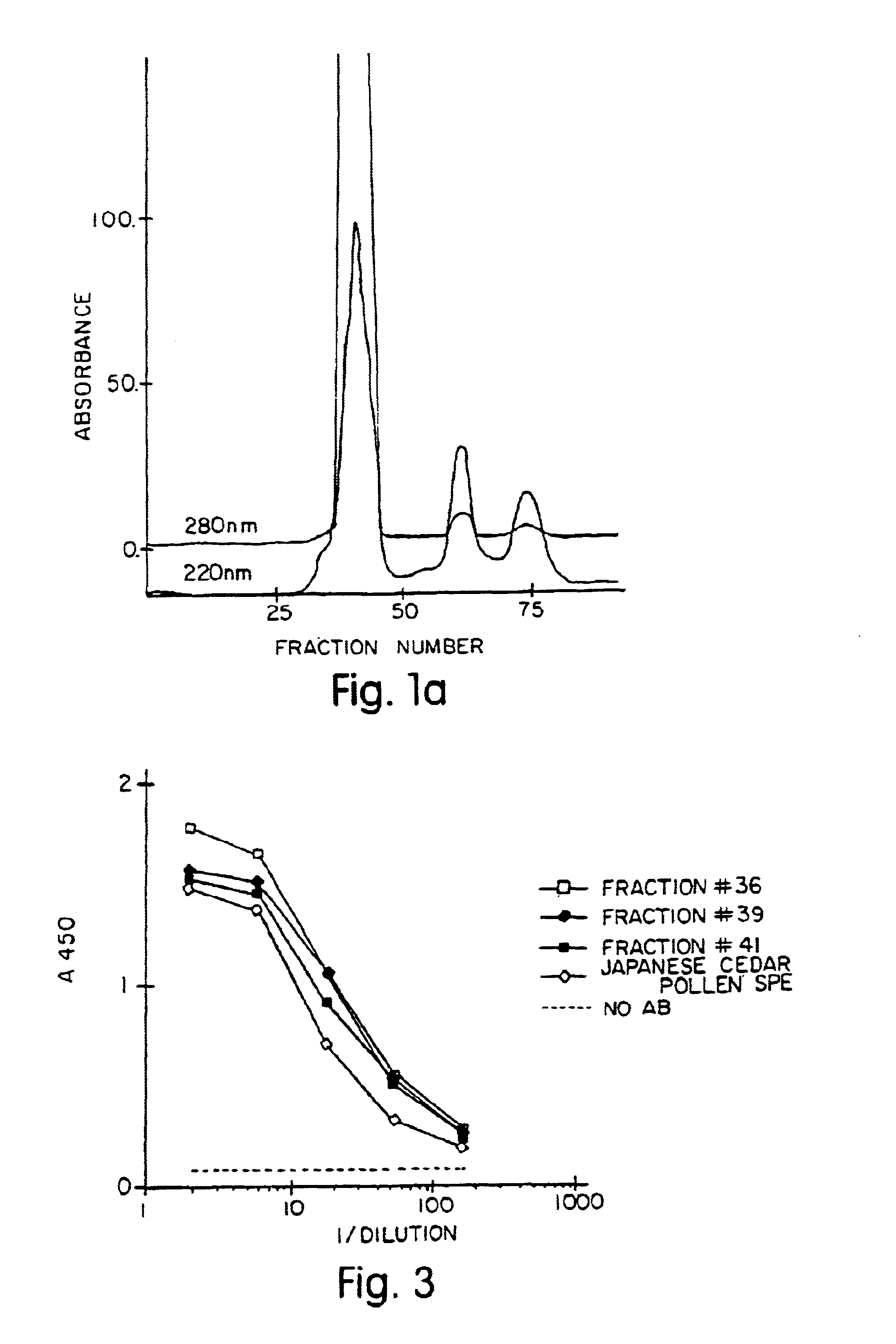Allergenic proteins and peptides from Japanese cedar pollen
a technology which is applied in the field of allergenic proteins and peptides from japanese cedar pollen, can solve the problems of long desensitization, long desensitization, and incomplete definition or characterization of the allergen responsible for the adverse effects of japanese cedar pollen on people, so as to prevent, diagnose, and treat japanese cedar pollen.
- Summary
- Abstract
- Description
- Claims
- Application Information
AI Technical Summary
Benefits of technology
Problems solved by technology
Method used
Image
Examples
example 1
Purification of Native Japanese Cedar Pollen Allergen (Cry j I)
[0257]The following is a description of the work done to biochemically purify the major allergen, Cry j I in the native form. The purification was modified from published procedures (Yasueda et al., J. Allergy Clin. Immunol. 71:77, 1983).
[0258]100 g of Japanese cedar pollen obtained from Japan (Hollister-Stier, Spokane, Wash.) was defatted in 1 L diethyl ether three times, the pollen was collected after filtration and the ether was dried off in a vacuum.
[0259]The defatted pollen was extracted at 4° C. overnight in 2 L extraction buffer containing 50 mM tris-HCL, pH 7.8, 0.2 M NaCl and protease inhibitors in final concentrations: soybean trypsin inhibitor (2 μg / ml), leupeptin (1 μg / ml), pepstatin A (1 μg / ml) and phenyl methyl sulfonyl fluoride (0.17 mg / ml). The insoluble material was reextracted with 1.2 L extraction buffer at 4° C. overnight and both extracts were combined together and depigmented by batch absorption wit...
example 2
Attempted Extraction of RNA From Japanese Cedar Pollen
[0267]Multiple attempts were made to obtain RNA from commercially-available, non-defatted, Cryptomeria japonica (Japanese cedar) pollen (Hollister Stier, Seattle, Wash.). Initially, the method of Sambrook et al., Molecular Cloning. A Laboratory Manual, Cold Spring Harbor Laboratory Press, Cold Spring Harbor, N.Y. (1989) was used in which the sample was suspended and lysed in 4 M guanidine buffer, ground under liquid nitrogen, and pelleted through 5.7 M cesium chloride by ultracentrifugation. Various amounts (3, 5 and 10 g) of pollen in varying amounts of guanidine lysis buffer (10 and 25 ml) were tried. Centrifugation through cesium resulted in viscous material in the bottom of the tube, from which it was not possible to recover an RNA pellet. Although it was possible to obtain RNA from defatted Ambrosia artemisiifolia (ragweed) pollen (Greer Laboratories, Lenior, N.C.) using this protocol, defatting the Cryptomeria japonica poll...
example 3
Extraction of RNA From Japanese Cedar Pollen and Staminate Cones and Cloning of Cry j I
[0272]Fresh pollen and staminate cone samples, collected from a single Cryptomeria japonica (Japanese cedar) tree at the Arnold Arboretum (Boston, Mass.), were frozen immediately on dry ice. RNA was prepared from 500 mg of each sample, essentially as described by Frankis and Mascarenhas, supra. The samples were ground by mortar and pestle on dry ice and suspended in 5 ml of 50 mM Tris pH 9.0 with 0.2 M NaCl, 1 mM EDTA, 1% SDS that had been treated overnight with 0.1% DEPC. After five extractions with phenol / chloroform / isoamyl alcohol (mixed at 25:24:1), the RNA was precipitated from the aqueous phase with 0.1 volume 2 M sodium acetate and 2 volumes ethanol. The pellets were recovered by centrifugation, resuspended in dH2O and heated to 65° C. for 5 min. Two ml of 4 M lithium chloride were added to the RNA preparations and they were incubated overnight at 0° C. The RNA pellets were recovered by cen...
PUM
| Property | Measurement | Unit |
|---|---|---|
| molecular weight | aaaaa | aaaaa |
| molecular weight | aaaaa | aaaaa |
| temperature | aaaaa | aaaaa |
Abstract
Description
Claims
Application Information
 Login to View More
Login to View More - R&D
- Intellectual Property
- Life Sciences
- Materials
- Tech Scout
- Unparalleled Data Quality
- Higher Quality Content
- 60% Fewer Hallucinations
Browse by: Latest US Patents, China's latest patents, Technical Efficacy Thesaurus, Application Domain, Technology Topic, Popular Technical Reports.
© 2025 PatSnap. All rights reserved.Legal|Privacy policy|Modern Slavery Act Transparency Statement|Sitemap|About US| Contact US: help@patsnap.com



